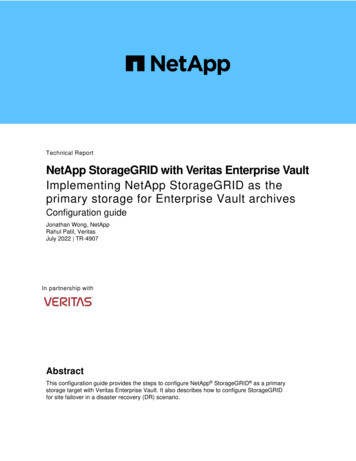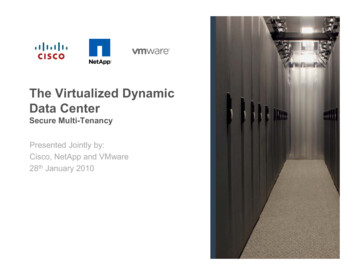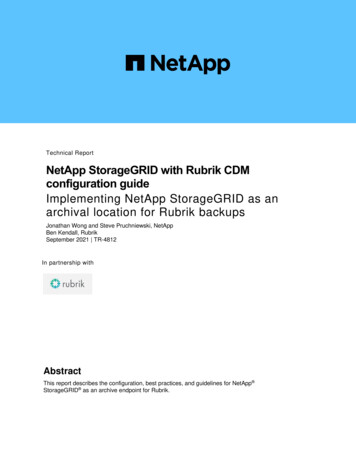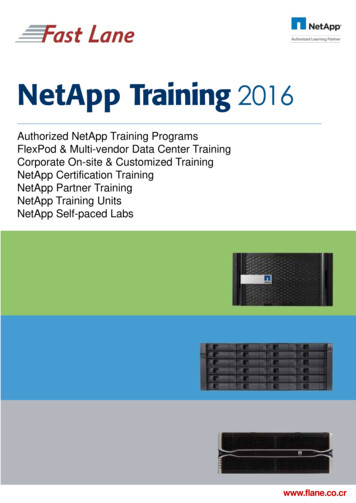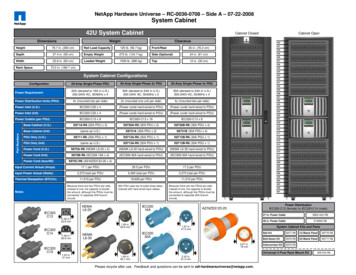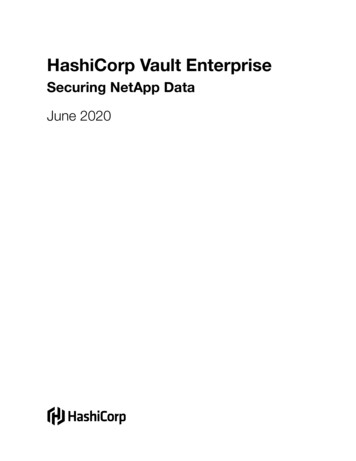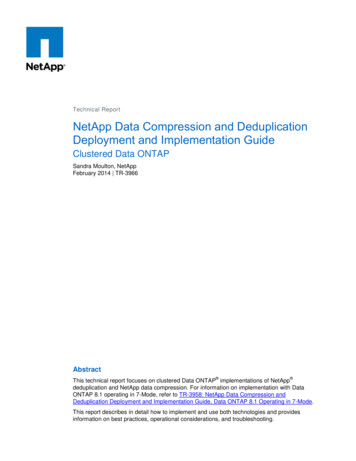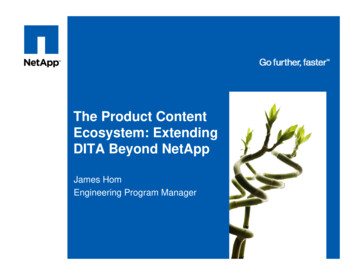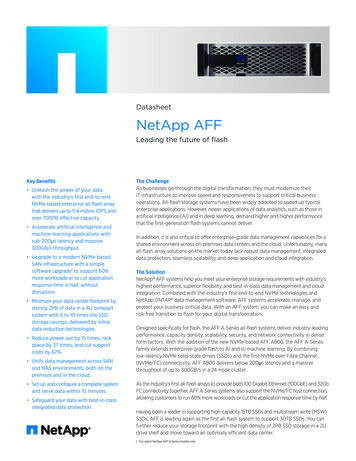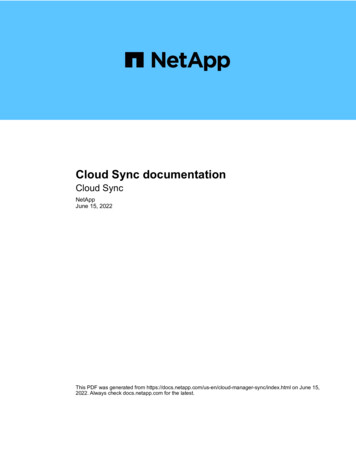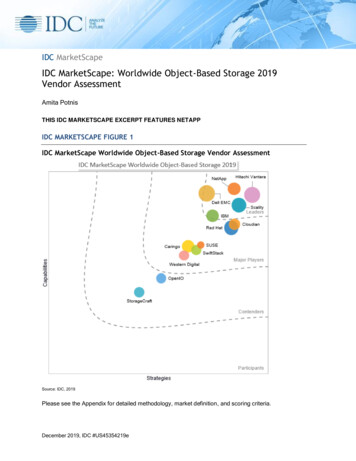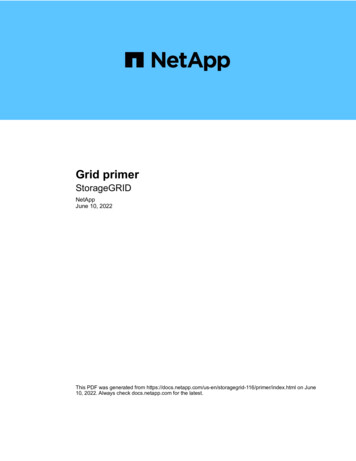
Transcription
Grid primerStorageGRIDNetAppJune 10, 2022This PDF was generated from er/index.html on June10, 2022. Always check docs.netapp.com for the latest.
Table of ContentsGrid primer . . . . . . . . . . . . . . . . . . . . . . . . . . . . . . . . . . . . . . . . . . . . . . . . . . . . . . . . . . . . . . . . . . . . . . . . . . . . . . 1Grid primer: Overview . . . . . . . . . . . . . . . . . . . . . . . . . . . . . . . . . . . . . . . . . . . . . . . . . . . . . . . . . . . . . . . . . . . 1Hybrid clouds with StorageGRID . . . . . . . . . . . . . . . . . . . . . . . . . . . . . . . . . . . . . . . . . . . . . . . . . . . . . . . . . . . 3StorageGRID architecture and network topology. . . . . . . . . . . . . . . . . . . . . . . . . . . . . . . . . . . . . . . . . . . . . . . 4Object management . . . . . . . . . . . . . . . . . . . . . . . . . . . . . . . . . . . . . . . . . . . . . . . . . . . . . . . . . . . . . . . . . . . . 14How to use StorageGRID. . . . . . . . . . . . . . . . . . . . . . . . . . . . . . . . . . . . . . . . . . . . . . . . . . . . . . . . . . . . . . . . 25
Grid primerGrid primer: OverviewUse these introduction to get an overview of the StorageGRID system and to learn aboutStorageGRID architecture and networking topology, data management features, and userinterface.What is StorageGRID?NetApp StorageGRID is a software-defined, object-based storage solution that supports industry-standardobject APIs, including the Amazon Simple Storage Service (S3) API and the OpenStack Swift API.StorageGRID provides secure, durable storage for unstructured data at scale. Integrated, metadata-drivenlifecycle management policies optimize where your data lives throughout its life. Content is placed in the rightlocation, at the right time, and on the right storage tier to reduce cost.StorageGRID is composed of geographically distributed, redundant, heterogeneous nodes, which can beintegrated with both existing and next-generation client applications.1
Advantages of the StorageGRID system include the following: Massively scalable and easy-to-use a geographically distributed data repository for unstructured data. Standard object storage protocols: Amazon Web Services Simple Storage Service (S3) OpenStack Swift Hybrid cloud enabled. Policy-based information lifecycle management (ILM) stores objects to public clouds,including Amazon Web Services (AWS) and Microsoft Azure. StorageGRID platform services enablecontent replication, event notification, and metadata searching of objects stored to public clouds. Flexible data protection to ensure durability and availability. Data can be protected using replication andlayered erasure coding. At-rest and in-flight data verification ensures integrity for long-term retention. Dynamic data lifecycle management to help manage storage costs. You can create ILM rules that managedata lifecycle at the object level, and customize data locality, durability, performance, cost, and retention2
time. Tape is available as an integrated archive tier. High availability of data storage and some management functions, with integrated load balancing tooptimize the data load across StorageGRID resources. Support for multiple storage tenant accounts to segregate the objects stored on your system by differententities. Numerous tools for monitoring the health of your StorageGRID system, including a comprehensive alertsystem, a graphical dashboard, and detailed statuses for all nodes and sites. Support for software or hardware-based deployment. You can deploy StorageGRID on any of the following: Virtual machines running in VMware. Container engines on Linux hosts. StorageGRID engineered appliances. Storage appliances provide object storage. Services appliances provide grid administration and load balancing services. Compliant with the relevant storage requirements of these regulations: Securities and Exchange Commission (SEC) in 17 CFR § 240.17a-4(f), which regulates exchangemembers, brokers or dealers. Financial Industry Regulatory Authority (FINRA) Rule 4511(c), which defers to the format and mediarequirements of SEC Rule 17a-4(f). Commodity Futures Trading Commission (CFTC) in regulation 17 CFR § 1.31(c)-(d), which regulatescommodity futures trading. Non-disruptive upgrade and maintenance operations. Maintain access to content during upgrade,expansion, decommission, and maintenance procedures. Federated identity management. Integrates with Active Directory, OpenLDAP, or Oracle Directory Servicefor user authentication. Supports single sign-on (SSO) using the Security Assertion Markup Language 2.0(SAML 2.0) standard to exchange authentication and authorization data between StorageGRID and ActiveDirectory Federation Services (AD FS).Hybrid clouds with StorageGRIDYou can use StorageGRID in a hybrid cloud configuration by implementing policy-drivendata management to store objects in Cloud Storage Pools, by leveraging StorageGRIDplatform services, and by moving data to StorageGRID with NetApp FabricPool.Cloud Storage PoolsCloud Storage Pools allow you to store objects outside of the StorageGRID system. For example, you mightwant to move infrequently accessed objects to lower-cost cloud storage, such as Amazon S3 Glacier, S3Glacier Deep Archive, or the Archive access tier in Microsoft Azure Blob storage. Or, you might want tomaintain a cloud backup of StorageGRID objects, which can be used to recover data lost because of a storagevolume or Storage Node failure.Using Cloud Storage Pools with FabricPool is not supported because of the added latency toretrieve an object from the Cloud Storage Pool target.3
S3 platform servicesS3 platform services give you the ability to use remote services as endpoints for object replication, eventnotifications, or search integration. Platform services operate independently of the grid’s ILM rules, and areenabled for individual S3 buckets. The following services are supported: The CloudMirror replication service automatically mirrors specified objects to a target S3 bucket, which canbe on Amazon S3 or a second StorageGRID system. The Event notification service sends messages about specified actions to an external endpoint thatsupports receiving Simple Notification Service (SNS) events. The search integration service sends object metadata to an external Elasticsearch service, allowingmetadata to be searched, visualized, and analyzed using third party tools.For example, you might use CloudMirror replication to mirror specific customer records into Amazon S3 andthen leverage AWS services to perform analytics on your data.ONTAP data tiering with StorageGRIDYou can reduce the cost of ONTAP storage by tiering data to StorageGRID using FabricPool. FabricPool is aNetApp Data Fabric technology that enables automated tiering of data to low-cost object storage tiers, eitheron or off premises.Unlike manual tiering solutions, FabricPool reduces total cost of ownership by automating the tiering of data tolower the cost of storage. It delivers the benefits of cloud economics by tiering to public and private cloudsincluding StorageGRID.Related information Administer StorageGRID Use a tenant account Manage objects with ILM Configure StorageGRID for FabricPoolStorageGRID architecture and network topologyA StorageGRID system consists of multiple types of grid nodes at one or more datacenter sites.For additional information about StorageGRID network topology, requirements, and grid communications, seethe Networking guidelines.Deployment topologiesThe StorageGRID system can be deployed to a single data center site or to multiple data center sites.Single siteIn a deployment with a single site, the infrastructure and operations of the StorageGRID system arecentralized.4
Multiple sitesIn a deployment with multiple sites, different types and numbers of StorageGRID resources can be installed ateach site. For example, more storage might be required at one data center than at another.Different sites are often located in geographically different locations across different failure domains, such asan earthquake fault line or flood plain. Data sharing and disaster recovery are achieved by automateddistribution of data to other sites.5
Multiple logical sites can also exist within a single data center to allow the use of distributed replication anderasure coding for increase availability and resiliency.Grid node redundancyIn a single-site or multi-site deployment, you can optionally include more than one Admin Node or GatewayNode for redundancy. For example, you can install more than one Admin Node at a single site or acrossseveral sites. However, each StorageGRID system can only have one primary Admin Node.System architectureThis diagram shows how grid nodes are arranged within a StorageGRID system.6
S3 and Swift clients store and retrieve objects in StorageGRID. Other clients are used to send emailnotifications, to access the StorageGRID management interface, and optionally to access the audit share.S3 and Swift clients can connect to a Gateway Node or an Admin Node to use the load-balancing interface toStorage Nodes. Alternatively, S3 and Swift clients can connect directly to Storage Nodes using HTTPS.Objects can be stored within StorageGRID on software or hardware-based Storage Nodes, on externalarchival media such as tape, or in Cloud Storage Pools, which consist of external S3 buckets or Azure Blobstorage containers.Grid nodes and servicesThe basic building block of a StorageGRID system is the grid node. Nodes contain services, which aresoftware modules that provide a set of capabilities to a grid node.7
The StorageGRID system uses four types of grid nodes: Admin Nodes provide management services such as system configuration, monitoring, and logging. Whenyou sign in to the Grid Manager, you are connecting to an Admin Node. Each grid must have one primaryAdmin Node and might have additional non-primary Admin Nodes for redundancy. You can connect to anyAdmin Node, and each Admin Node displays a similar view of the StorageGRID system. However,maintenance procedures must be performed using the primary Admin Node.Admin Nodes can also be used to load balance S3 and Swift client traffic. Storage Nodes manage and store object data and metadata. Each StorageGRID system must have atleast three Storage Nodes. If you have multiple sites, each site within your StorageGRID system must alsohave three Storage Nodes. Gateway Nodes (optional) provide a load-balancing interface that client applications can use to connectto StorageGRID. A load balancer seamlessly directs clients to an optimal Storage Node, so that the failureof nodes or even an entire site is transparent. You can use a combination of Gateway Nodes and AdminNodes for load balancing, or you can implement a third-party HTTP load balancer. Archive Nodes (optional) provide an interface through which object data can be archived to tape.To learn more, see Administer StorageGRID.Software-based nodesSoftware-based grid nodes can be deployed in the following ways: As virtual machines (VMs) in VMware vSphere Within container engines on Linux hosts. The following operating systems are supported: Red Hat Enterprise Linux CentOS Ubuntu DebianSee the following for more information: Install VMware Install Red Hat Enterprise Linux or CentOS Install Ubuntu or DebianUse the NetApp Interoperability Matrix Tool to get a list of supported versions.StorageGRID appliance nodesStorageGRID hardware appliances are specially designed for use in a StorageGRID system. Some appliancescan be used as Storage Nodes. Other appliances can be used as Admin Nodes or Gateway Nodes. You cancombine appliance nodes with software-based nodes or deploy fully engineered, all-appliance grids that haveno dependencies on external hypervisors, storage, or compute hardware.Four types of StorageGRID appliances are available: The SG100 and SG1000 services appliances are 1-rack-unit (1U) servers that can each operate as theprimary Admin Node, a non-primary Admin Node, or a Gateway Node. Both appliances can operate as8
Gateway Nodes and Admin Nodes (primary and non-primary) at the same time. The SG6000 storage appliance operates as a Storage Node and combines the 1U SG6000-CN computecontroller with a 2U or 4U storage controller shelf. The SG6000 is available in three models: SGF6024: Combines the SG6000-CN compute controller with a 2U storage controller shelf thatincludes 24 solid state drives (SSDs) and redundant storage controllers. SG6060 and SG6060X: Combines the SG6000-CN compute controller with a 4U enclosure thatincludes 58 NL-SAS drives, 2 SSDs, and redundant storage controllers. SG6060 and SG6060X eachsupport one or two 60-drive expansion shelves, providing up to 178 drives dedicated to object storage. The SG5700 storage appliance is an integrated storage and computing platform that operates as aStorage Node. The SG5700 is available in four models: SG5712 and SG5712X: a 2U enclosure that includes 12 NL-SAS drives and integrated storage andcompute controllers. SG5760 and SG5760X: a 4U enclosure that includes 60 NL-SAS drives and integrated storage andcompute controllers. The SG5600 storage appliance is an integrated storage and computing platform that operates as aStorage Node. The SG5600 is available in two models: SG5612: a 2U enclosure that includes 12 NL-SAS drives and integrated storage and computecontrollers. SG5660: a 4U enclosure that includes 60 NL-SAS drives and integrated storage and computecontrollers.See the following for more information: NetApp Hardware Universe SG100 and SG1000 services appliances SG6000 storage appliances SG5700 storage appliances SG5600 storage appliancesPrimary services for Admin NodesThe following table shows the primary services for Admin Nodes; however, this table does not list all nodeservices.ServiceKey functionAudit Management System (AMS)Tracks system activity.Configuration Management Node(CMN)Manages system-wide configuration. Primary Admin Node only.Management Application ProgramInterface (mgmt-api)Processes requests from the Grid Management API and the TenantManagement API.9
ServiceKey functionHigh AvailabilityManages high availability virtual IP addresses for groups of AdminNodes and Gateway Nodes.Note: This service is also found on Gateway Nodes.Load BalancerProvides load balancing of S3 and Swift traffic from clients to StorageNodes.Note: This service is also found on Gateway Nodes.Network Management System(NMS)Provides functionality for the Grid Manager.PrometheusCollects and stores metrics.Server Status Monitor (SSM)Monitors the operating system and underlying hardware.Primary services for Storage NodesThe following table shows the primary services for Storage Nodes; however, this table does not list all nodeservices.Some services, such as the ADC service and the RSM service, typically exist only on threeStorage Nodes at each site.ServiceKey functionAccount (acct)Manages tenant accounts.Administrative Domain Controller(ADC)Maintains topology and grid-wide configuration.CassandraStores and protects object metadata.Cassandra ReaperPerforms automatic repairs of object metadata.ChunkManages erasure-coded data and parity fragments.Data Mover (dmv)Moves data to Cloud Storage Pools.Distributed Data Store (DDS)Monitors object metadata storage.Identity (idnt)Federates user identities from LDAP and Active Directory.10
ServiceKey functionLocal Distribution Router (LDR)Processes object storage protocol requests and manages object data ondisk.Replicated State Machine (RSM)Ensures that S3 platform service requests are sent to their respectiveendpoints.Server Status Monitor (SSM)Monitors the operating system and underlying hardware.Primary services for Gateway NodesThe following table shows the primary services for Gateway Nodes; however, this table does not list all nodeservices.ServiceKey functionConnection Load Balancer (CLB)Provides Layers 3 and 4 load balancing of S3 and Swift traffic fromclients to Storage Nodes. Legacy load balancing mechanism.Note: The CLB service is deprecated.High AvailabilityManages high availability virtual IP addresses for groups of AdminNodes and Gateway Nodes.Note: This service is also found on Admin Nodes.Load BalancerProvides Layer 7 load balancing of S3 and Swift traffic from clients toStorage Nodes. This is the recommended load balancing mechanism.Note: This service is also found on Admin Nodes.Server Status Monitor (SSM)Monitors the operating system and underlying hardware.Primary services for Archive NodesThe following table shows the primary services for Archive Nodes; however, this table does not list all nodeservices.ServiceKey functionArchive (ARC)Communicates with a Tivoli Storage Manager (TSM) external tapestorage system.Server Status Monitor (SSM)Monitors the operating system and underlying hardware.StorageGRID servicesThe following is a complete list of StorageGRID services.11
Account Service ForwarderProvides an interface for the Load Balancer service to query the Account Service on remote hosts andprovides notifications of Load Balancer Endpoint configuration changes to the Load Balancer service. TheLoad Balancer service is present on Admin Nodes and Gateway Nodes. ADC service (Administrative Domain Controller)Maintains topology information, provides authentication services, and responds to queries from the LDRand CMN services. The ADC service is present on each of the first three Storage Nodes installed at a site. AMS service (Audit Management System)Monitors and logs all audited system events and transactions to a text log file. The AMS service is presenton Admin Nodes. ARC service (Archive)Provides the management interface with which you configure connections to external archival storage,such as the cloud through an S3 interface or tape through TSM middleware. The ARC service is present onArchive Nodes. Cassandra Reaper servicePerforms automatic repairs of object metadata. The Cassandra Reaper service is present on all StorageNodes. Chunk serviceManages erasure-coded data and parity fragments. The Chunk service is present on Storage Nodes. CLB service (Connection Load Balancer)Deprecated service that provides a gateway into StorageGRID for client applications connecting throughHTTP. The CLB service is present on Gateway Nodes. The CLB service is deprecated and will be removedin a future StorageGRID release. CMN service (Configuration Management Node)Manages system-wide configurations and grid tasks. Each grid has one CMN service, which is present onthe primary Admin Node. DDS service (Distributed Data Store)Interfaces with the Cassandra database to manage object metadata. The DDS service is present onStorage Nodes. DMV service (Data Mover)Moves data to cloud endpoints. The DMV service is present on Storage Nodes. Dynamic IP serviceMonitors the grid for dynamic IP changes and updates local configurations. The Dynamic IP (dynip) serviceis present on all nodes.12
Grafana serviceUsed for metrics visualization in the Grid Manager. The Grafana service is present on Admin Nodes. High Availability serviceManages high availability Virtual IPs on nodes configured on the High Availability Groups page. The HighAvailability service is present on Admin Nodes and Gateway Nodes. This service is also known as thekeepalived service. Identity (idnt) serviceFederates user identities from LDAP and Active Directory. The Identity service (idnt) is present on threeStorage Nodes at each site. Lambda Arbitrator serviceManages S3 Select SelectObjectContent requests. Load Balancer serviceProvides load balancing of S3 and Swift traffic from clients to Storage Nodes. The Load Balancer servicecan be configured through the Load Balancer Endpoints configuration page. The Load Balancer service ispresent on Admin Nodes and Gateway Nodes. This service is also known as the nginx-gw service. LDR service (Local Distribution Router)Manages the storage and transfer of content within the grid. The LDR service is present on Storage Nodes. MISCd Information Service Control Daemon serviceProvides an interface for querying and managing services on other nodes and for managing environmentalconfigurations on the node such as querying the state of services running on other nodes. The MISCdservice is present on all nodes. nginx serviceActs as an authentication and secure communication mechanism for various grid services (such asPrometheus and Dynamic IP) to be able to talk to services on other nodes over HTTPS APIs. The nginxservice is present on all nodes. nginx-gw servicePowers the Load Balancer service. The nginx-gw service is present on Admin Nodes and Gateway Nodes. NMS service (Network Management System)Powers the monitoring, reporting, and configuration options that are displayed through the Grid Manager.The NMS service is present on Admin Nodes. Persistence serviceManages files on the root disk that need to persist across a reboot. The Persistence service is present onall nodes. Prometheus service13
Collects time series metrics from services on all nodes. The Prometheus service is present on AdminNodes. RSM service (Replicated State Machine Service)Ensures platform service requests are sent to their respective endpoints. The RSM service is present onStorage Nodes that use the ADC service. SSM service (Server Status Monitor)Monitors hardware conditions and reports to the NMS service. An instance of the SSM service is presenton every grid node. Trace collector servicePerforms trace collection to gather information for use by technical support. The trace collector serviceuses open source Jaeger software and is present on Admin Nodes.Object managementHow StorageGRID manages dataAs you begin working with the StorageGRID system, it is helpful to understand how theStorageGRID system manages data.What an object isWith object storage, the unit of storage is an object, rather than a file or a block. Unlike the tree-like hierarchyof a file system or block storage, object storage organizes data in a flat, unstructured layout. Object storagedecouples the physical location of the data from the method used to store and retrieve that data.Each object in an object-based storage system has two parts: object data and object metadata.Object dataObject data might be anything; for example, a photograph, a movie, or a medical record.Object metadataObject metadata is any information that describes an object. StorageGRID uses object metadata to track thelocations of all objects across the grid and to manage each object’s lifecycle over time.Object metadata includes information such as the following: System metadata, including a unique ID for each object (UUID), the object name, the name of the S314
bucket or Swift container, the tenant account name or ID, the logical size of the object, the date and timethe object was first created, and the date and time the object was last modified. The current storage location of each object copy or erasure-coded fragment. Any user metadata associated with the object.Object metadata is customizable and expandable, making it flexible for applications to use.For detailed information about how and where StorageGRID stores object metadata, go to Manage objectmetadata storage.How object data is protectedThe StorageGRID system provides you with two mechanisms to protect object data from loss: replication anderasure coding.ReplicationWhen StorageGRID matches objects to an information lifecycle management (ILM) rule that is configured tocreate replicated copies, the system creates exact copies of object data and stores them on Storage Nodes,Archive Nodes, or Cloud Storage Pools. ILM rules dictate the number of copies made, where those copies arestored, and for how long they are retained by the system. If a copy is lost, for example, as a result of the loss ofa Storage Node, the object is still available if a copy of it exists elsewhere in the StorageGRID system.In the following example, the Make 2 Copies rule specifies that two replicated copies of each object be placedin a storage pool that contains three Storage Nodes.Erasure codingWhen StorageGRID matches objects to an ILM rule that is configured to create erasure-coded copies, it slicesobject data into data fragments, computes additional parity fragments, and stores each fragment on a different15
Storage Node. When an object is accessed, it is reassembled using the stored fragments. If a data or a parityfragment becomes corrupt or lost, the erasure coding algorithm can recreate that fragment using a subset ofthe remaining data and parity fragments. ILM rules and erasure coding profiles determine the erasure codingscheme used.The following example illustrates the use of erasure coding on an object’s data. In this example, the ILM ruleuses a 4 2 erasure coding scheme. Each object is sliced into four equal data fragments, and two parityfragments are computed from the object data. Each of the six fragments is stored on a different Storage Nodeacross three data centers to provide data protection for node failures or site loss.Related information Manage objects with ILM Use information lifecycle managementObject lifecycleThe life of an objectAn object’s life consists of various stages. Each stage represents the operations thatoccur with the object.The life of an object includes the operations of ingest, copy management, retrieve, and delete. Ingest: The process of an S3 or Swift client application saving an object over HTTP to the StorageGRIDsystem. At this stage, the StorageGRID system begins to manage the object. Copy management: The process of managing replicated and erasure-coded copies in StorageGRID, asdescribed by the ILM rules in the active ILM policy. During the copy management stage, StorageGRIDprotects object data from loss by creating and maintaining the specified number and type of object copieson Storage Nodes, in a Cloud Storage Pool, or on Archive Node.16
Retrieve: The process of a client application accessing an object stored by the StorageGRID system. Theclient reads the object, which is retrieved from a Storage Node, Cloud Storage Pool, or Archive Node. Delete: The process of removing all object copies from the grid. Objects can be deleted either as a result ofthe client application sending a delete request to the StorageGRID system, or as a result of an automaticprocess that StorageGRID performs when the object’s lifetime expires.Related information Manage objects with ILM Use information lifecycle managementIngest data flowAn ingest, or save, operation consists of a defined data flow between the client and theStorageGRID system.Data flowWhen a client ingests an object to the StorageGRID system, the LDR service on Storage Nodes processes therequest and stores the metadata and data to disk.17
1. The client application creates the object and sends it to the StorageGRID system through an HTTP PUTrequest.2. The object is evaluated against the system’s ILM policy.3. The LDR service saves the object data as a replicated copy or as an erasure coded copy. (The diagramshows a simplified version of storing a replicated copy to disk.)4. The LDR service sends the object metadata to the metadata store.5. The metadata store saves the object metadata to disk.6. The metadata store propagates copies of object metadata to other Storage Nodes. These copies are alsosaved to disk.7. The LDR service returns an HTTP 200 OK response to the client to acknowledge that the object has beeningested.Copy managementObject data is managed by the active ILM policy and its ILM rules. ILM rules makereplicated or erasure coded copies to protect object data from loss.Different types or locations of object copies might be required at different times in the object’s life. ILM rules areperiodically evaluated to ensure that objects are placed as required.Object data is managed by the LDR service.Content protection: replicationIf an ILM rule’s content placement instructions require replicated copies of object data, copies are made andstored to disk by the Storage Nodes that make up the configured storage pool.Data flowThe ILM engine in the LDR service controls replication and ensures that the correct number of copies arestored in the correct locations and for the correct amount of time.18
1. The ILM engine queries the ADC service to determine the best destination LDR service within the storagepool specified by the ILM rule. It then sends that LDR service a command to initiate replication.2. The destination LDR service queries the ADC service for the best source location. It then sends areplication request to the source LDR service.3. The source LDR service sends a copy to the destination LDR service.4. The destination LDR service notifies the ILM engine that the object data has been stored.5. The ILM engine updates the metadata store with object location metadata.Content protection: erasure codingIf an ILM rule includes instructions to make erasure coded copies of object data, the applicable erasure codingscheme breaks object data into data and parity fragments and distributes these fragments across the StorageNodes configured in the Erasure Coding profile.Data flowThe ILM engine, which is a component of the LDR service, controls erasure coding and ensures that theErasure Coding profile is applied to object data.19
1. The ILM engine queries the ADC service to determine which DDS service can best perform the erasurecoding operation. Once determined, the ILM engine sends an "initiate" request to that service.2. The DDS service instructs an LDR to erasure code the object data.3. The source LDR service sends a copy to the LDR service selected for erasure coding.4. Once broken into the appropriate number of parity and data fragments, the LDR service distributes thesefragments across the Storage No
The SG5600 storage appliance is an integrated storage and computing platform that operates as a Storage Node. The SG5600 is available in two models: SG5612: a 2U enclosure that includes 12 NL-SAS drives and integrated storage and compute controllers. SG5660: a 4U enclosure that includes 60 NL-SAS drives and integrated storage and compute
